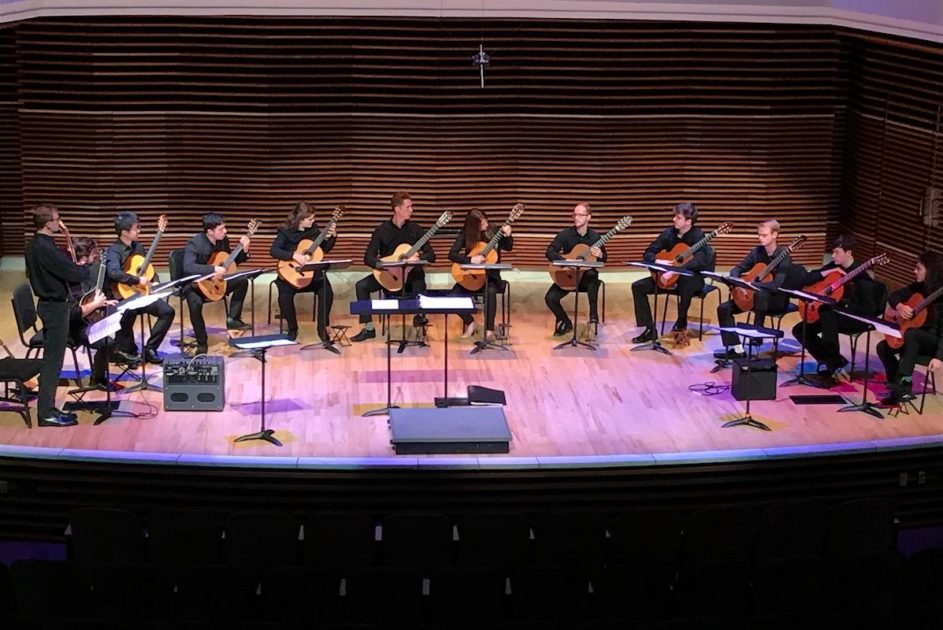Classical guitar music is always special. A classical guitar ensemble with 12 musicians playing guitars that range from high soprano to low contra-bass guitars, ukuleles and mandolins is very special indeed.
That’s what the Indiana Guitar Ensemble brought to the University of Tennessee School of Music Saturday afternoon.
Composed of both undergraduate and graduate students at Indiana University’s Jacobs School of Music, the ensemble played a program of all 20th-century works, with several of the pieces written for them.
As in much new music, the performance techniques went beyond the traditional fingers strumming or plucking strings to using the guitar body as a drum, making eerie sounds by sliding the fingers up the strings on the fret board, and stomping feet.
The ensemble’s director and founder, Daniel Duarte, arranged several of the pieces, including his charming arrangement of three movements from Heitor Villa-Lobos’ 1951 “Concerto for Guitar and Small Orchestra.” Eleven of the guitarists played 11 different orchestra parts, with the solo guitar part moving around the ensemble.
Played relatively softly in the orchestral parts, the first two movements created an effect akin to standing in the middle of a flower bed while musical bees hummed tunes as they buzzed around one’s head moving from flower to flower, especially in the “Andantino” second movement. The third movement was bold and assertive.
UT faculty composer and clarinetist Jorge Variego joined the ensemble for a performance of Duarte’s arrangement for clarinet and guitar ensemble of the “Aria” from Villa-Lobos “Bachianas Brasileiras No. 5, written over a span of seven years, 1938-1945.
Originally written for soprano and cellos, Variego’s clarinet had mellow vocal qualities that were smooth and lyrical.
One of the most interesting pieces on the program was Craig M. Davis’ “Floating Cities,” commissioned by IU Guitar Ensemble. Duarte encouraged the audience to move around the auditorium during the piece to get different listening perspectives on the music.
The players on one side of the group initiated a phrase, followed by the players opposite them playing a kind of echo, producing the effect of a dynamic sense of depth.
The sound flowed in wave patterns with the sound level rising and lowering while at the same time the voices moved from one side to the other. It was a magical experience of pulsing, ebbing and flowing.
In three movements from Alberto Ginastera’s 1941 “Danzas” from his ballet “Estancia,” again arranged by Duarte, the first movement featured aggressive staccato chords, knocking on the instrument bodies, snapping and slapping the guitar strings and foot stomps.
In sharp contrast, the second movement was a slow dance with lush, flowing phrases, trills on the mandolin and atmospheric harmonics played up on the necks of the guitars, which produced a transparent sound cloud.
The closing work, “Shumba,” was written last year by Variego for the ensemble. It featured two electric guitars. Basically a tango, the piece boasted the electric instruments producing mysterious wah-wahs and slurs set against violent, choppy notes on the acoustic guitars.
At moments the wobbles on the electric guitars faded into tango rhythms that emerged from sounds that were somewhere between wind blowing and a hinge slowly creaking.
This was the 69th concert of the 2018-2019 school year at the UT School of Music. The majority of these programs are free to the public. Information about the concert and events schedule can be found here or by calling 865-974-8935.

University of Tennessee composer and clarinetist Jorge Variego performs with the Indiana Guitar Ensemble. Conductor Daniel Duarte is shown with his back to the camera.

